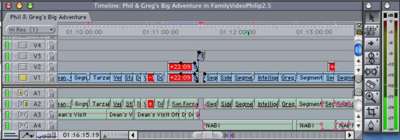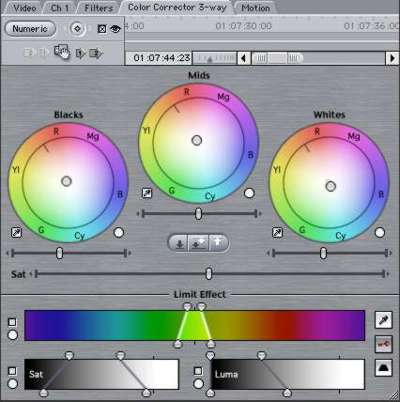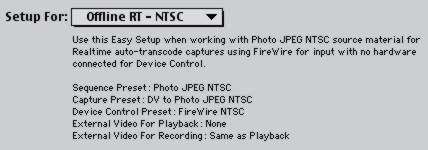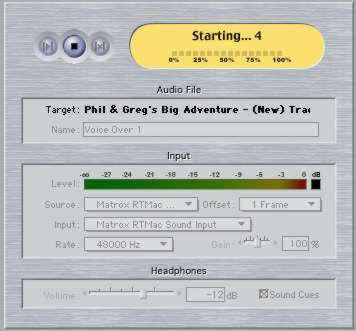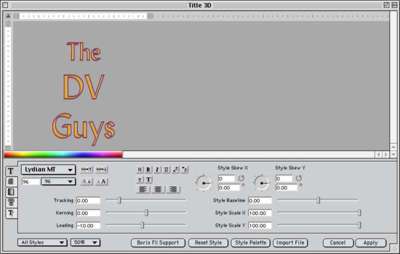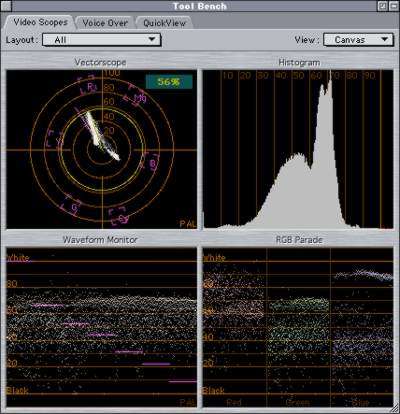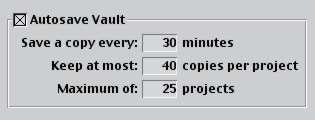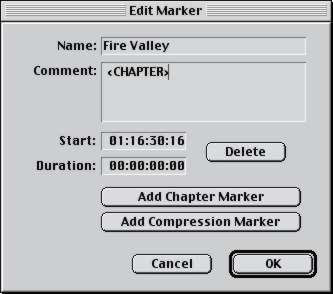
Guide to Final Cut Pro 3 December 18, 2001
What's new in Final Cut Pro 3
A First "Hands On" Look
by Philip Hodgetts
COMPANY: Apple Computer
CONTACT: http://www.apple.com/finalcutpro
PRICE: $999.00 ($299.00, upgrade)
REQUIREMENTS:Macintosh computer with a 300-MHz
or faster PowerPC G3 or G4 processor and built-in FireWire
500-MHz or faster single or dual processor Power Mac G4 or PowerBook G4 required for G4 realtime effects
667-MHz PowerBook G4 required for mobile G4 realtime effects in DV format
Mac OS 9.2.2 or Mac OS X v10.1.1
QuickTime (included)
256MB of RAM (384MB recommended for G4 realtime effects)
40MB of available disk space required for installation
NOTE: Unless you hve a high speed connection, this page will take awhile to load
New Features
From the discussions on various email groups and conversations among users, you would think Apple only released on new feature: G4 FX otherwise known as real-time preview or more accurately, real-time editing. Although real-time editing is one of the 'headline' features, this latest release is full of great new productive features:
- G4 real-time Effects
OS X support
Color Correction & Color Correction Workflow
OfflineRT
Record Voice Over to the Timeline
QuickView - RAM Preview
Boris Calligraphy Text Generators
Video Scopes - Waveform Monitor, Vectorscope, Histogram and RGB Parade
CGM Filters and Transitions
Autosave Vault
External Editors
Compression and Chapter Markers ready for when DVD Studio Pro 2 for Mac OS X ships.
Dozens of other featuresAny one of these features alone would make this a valuable upgrade, combined they add an awesome amount of extra power to Final Cut Pro 3. Writing a tour of the new features is difficult, because if I focus on the 'big ticket' items it's very easy to miss the dozens of small enhancements that make everyday editing more productive. Final Cut Pro 3 should put to rest, once and for all, any questions about how 'serious' Apple is in building Final Cut Pro as a professional editing and finishing tool. The features in this release are clearly aimed at the 'high end' of the market as well as providing features every working editor will value.
Because the release is so new, it's still too early to comment on stability (although I haven't crashed it ever on either Operating System) or what "bugs" have been fixed. Luckily for me I've had none of the 'broken Timecode', 'limited capture time' or any of the other problems that have been reported. Since I never experienced the problem on my system I cannot verify or even comment on the likelihood of any 'fix'. Although I can say, in general terms, if a software manufacturer is aware of what the cause of an issue is, they fix it in the next available release.
G4 real-time Effects
Of all the new features in Final Cut Pro 3, this is the one that has caused the greatest confusion and is probably the least well understood. Let's see if we can cut through the confusion and see the advantages, limitations and practical use of G4 real-time Effects.G4 only
The first point to note is that they are G4 real-time effects. I won't be using them on my otherwise very serviceable iBook, nor on any G3 powered iMac or PowerBook. I won't even be using them on my 9-month-old G4/466 because the minimum single processor requirement is a G4/500. Unless FCP sees that processor speed, the real-time effects are disabled. All dual processor G4s (including the 450s) will do some level of real-time G4 FX, and if you're on a G4 Titanium PowerBook you can do real-time offline on the 500 MHz models. Real time DV effect requirements are less clear - but reading between the different specification sheets and FAQs it seems if you had a top of the range 500 MHz from the last series or the current 667 you can do real time DV but may not be able to if you have a 550 MHz G4 Titanium PowerBook in the current generation.G4 real-time should not be confused with the OfflineRT, which is covered later. G4 real-time effects will work with the OfflineRT footage or DV. It will not work with any other format such as Igniter, CinéWave, Digital Voodoo or source footage.
Preview only
G4 real-time effects are previews and playback only to the desktop and only in preview resolution, although the preview resolution improves with processor power and generally wouldn't be an issue for general editing. There is insufficient power to add a real-time encode to DV on top of the effects. When working in G4 real-time mode, the FireWire output is disabled and nothing goes out the FireWire to a hardware DV device.This is just a fact of life at the moment - encoding to DV takes processing power and when you're doing two DV software decodes and processing the effect, it's not yet possible to add the extra step of an encode. That's where an RTMac has the advantage of having hardware DV Codecs to take load off the processor.
So, if they're only preview and only on the desktop, what good are they? "Heaps good" as my younger associates would say. It is on the desktop and quality is depending on processor, but for timing decisions the use of G4 real-time is a major benefit. And timing decisions are the basic stuff of video editing and effects application.
Timing decision like: exactly how fast the title fades up or moves across the screen; the speed of a dissolve and when it starts or stops relative to the image; the speed and direction of a transition relative to the video and so much more. These decisions do not necessarily need to see video in its true colorspace or at full quality to make decisions and speed productivity. While Apple don't particularly like the term, this is real-time editing because there is NO waiting while you make effect timing decisions. There is a one-off render to DV at the end but there are not 5, 10 or 20 renders while you experiment to get the timing right.
Monitoring on a video monitor
But, I hear you say, you do need to see it on a video monitor for color correction, and that is certainly true. The gamma of a computer monitor is different to that of a video monitor and for accurate color correction you need to work on a video monitor. Real-time G4 effects can be monitored on a video monitor by taking the output from a graphics card. G4 PowerBooks have an Svideo output, a Radeon graphics card has S-video output and using either you can monitor, in real-time with no delay, what you're seeing on the computer monitor on the video monitor. Simply set the video out preference to "Desktop 2 (720x480) and all playback goes directly to the second desktop. Both monitors stay in sync while editing. Move the Canvas window so it displays on the Radeon card's monitor, scale it up to full size and it's mirrored.It is not as good a solution as true video out and if you want that, then RTMac remains a great solution for more real-time effects than G4 real-time. The only limitation being that you work with Color Correction on still images but I'm happy with that. (I'd work on a still anyway.) The video-out-graphics-card is most certainly good enough to accurately judge color correction but will always have interface elements present on the video monitor.
Note: It's either G4 real-time effects OR an RTMac. Final Cut Pro 3 disables real-time effects if it detects the presence of an RTMac card. Since you only need one real time output, that's practical, not a limitation.
What's available for G4 real-time?
- Cross Dissolve
- Iris transitions: Cross Iris, Diamond Iris, Oval Iris, Point Iris, Rectangle Iris, Star Iris
- Wipe transitions: Center Wipe, Clock Wipe, Edge Wipe, Inset Wipe, V Wipe
- 3 Way Color Corrector filter
- real-time motion effects: Opacity, Scale, Center (Position), Offset, Crop and Aspect ratio
- real-time Still Frames from Video stills or imported graphics play in real-time at preview resolution. There is no restriction on the number of stills in the Sequence, although more stills require a larger RT Still Cache to be set in General Preferences.
You get what you pay for
While we all would have been ecstatic if Apple had managed to include real-time effects for every Macintosh that runs Final Cut Pro with no extra hardware, such magic is not possible here in the real world where real limitations require engineering and 'public relations' compromises.
That we have the level of real-time effects we do now, included as just one feature in a feature packed upgrade for a very reasonable upgrade price, is as far as the engineering can be pushed, right now. More importantly the effects are totally scalable - throw more processor power at it, more effects become real-time, so as processor power increases the capabilities of real-time G4 Effects so they will automatically get more powerful with faster and more processors.What about the RTMac
Since I don't have a qualified G4 I will be using my RTMac for a while and it still has some advantages - full quality, full frame rate real time effects on video monitor, analog to DV digitize, preview single frames of Color Correction to the RTMac with Shift+F12, second monitor support and some extra effects not yet supported in the software G4 real time effects. It's going to be paying for itself for a while yet.Summary
- Real-time G4 Effects work with both Offline RT (PhotoJPEG) media and with DV Media
- Requires G4/500 or dual G4 processor before it becomes available at all
- Previews real-time to the desktop for real-time edit decisions
- Monitor the preview video on an NTSC/PAL monitor via any graphics card with a video output for preview in video gamma
- Swap back to FireWire/DV output with Easy Setup for full video quality
- Only one render before mastering, not multiple renders while making edit/effect decisions
OS X Support
Final Cut Pro 3 is the first release that will run in OS X. Final Cut Pro 3 has identical features on OS X as it does on OS 9; it runs at the same speed on either operating system (more or less) and looks almost exactly the same. Apple has gone to a lot of effort not to exclude OS 9 users who are not ready, or able, to transition to OS X just yet.When you're ready to make the transition to OS X Final Cut Pro 3 will be there and will integrate into an all OS X workflow. The look is still mostly the same Final Cut Pro appearance we've loved for nearly 3 years with only basic compliance with the Aqua interface guidelines.
Personally, having seen what at least one other NLE has done with OS X conversion I was hoping for an Aqua remake. And sometimes the Aqua elements in the original interface look out of place. Having seen what was done with QuickTime Player and iTunes in the OS X conversions, I think it would be possible to retain most of the familiar look and yet give it an Aqua look and feel, but no doubt there will be future OS revision for more OS X Aqua compliance. From a purely personal business motivation, I'm pleased the interface is substantially the same as it will make an OS X compatible version of the DV Companion - The Intelligent Assistant for Final Cut Pro 3 much less work than remaking all 3 hours of sprite movies.
Click to view larger imageFor now, running in OS X provides no specific benefits for the operation of Final Cut Pro. Running in OS X is a benefit because there is no need to assign RAM, you can work in the background while rendering and in theory it's more stable, but in practice Final Cut Pro so rarely crashes in OS 9 or X that's almost irrelevant. If it does crash you can just restart the application in OS X. The good news is that there are absolutely no disadvantages to working with Final Cut Pro 3 in OS X.
As other applications become available for OS X, it will make migration easier. Projects are completely cross platform compatible - you can start a project in OS 9, open it in OS X and work on it, then open it again in OS 9 with no penalty.
Although OS X is a true multi-tasking Operating System, don't expect to gain too much benefit from it right now. Perhaps future versions will allow render-in-the-background like iMovie but for now, rendering in Final Cut Pro stops all editing functions. The redeeming feature is, of course, while rendering in Final Cut Pro 3 you can work productively with other applications on the same Macintosh.
OS X support is there; it seems solid and reliable so when you're ready to go, you can make a seamless transition. However, you might be waiting for a while for RTMac, Cinéwave and Digital Voodoo support on OS X. According to reliable sources first out of the gate with OS X hardware support will probably be from the AJA/Blackmagic combination, although it's not yet an officially supported configuration.
Color Correction & Color Correction Workflow
Color Correction was the feature that caught my attention at first look, particularly the 3-way Color Corrector filter, which is one of the G4 real-time effects on a suitable G4. On lesser Macintoshes it is a render effect that previews on a still image out the FireWire through a DV device like all other filters.
These new Color Correction filters have their visual interface in their own tab in the Viewer window. Controls are duplicated between the visual interface and the numeric controls for the same filter in the Filters Tab. Each Color Correction filter you apply adds another tab for the new visual interface controls for primary and secondary color correction.
Primary Color Correction
The 3 Circular controls parallel the joystick controls on high end color correction tools - one each for Blacks, Mids and Whites. (In fact, if you have a suitable trackball there's a trick that lets you use the trackball for color correction control.) You can push each of the three tonal group controls to manually correct the color, or click the appropriate color picker button. Clicking on a buttons lets you select a color from within the tonal group that is used to auto-correct that color. For example, click the Whites picker, and then click on a pixel in the image you want to be displayed as truly white. The whites are adjusted accordingly. Fine tune the result to taste
Black balance is equally simple, with auto-correct or manual intervention and ditto the mid tones of the image. Use the automatic adjustment as a starting point and fine-tune manually, but you'll find the auto correction consistent, particularly if you have a consistent reference object.
Beneath each color wheel are individual controls for brightness for each tonal group and an overall saturation control. In the center are 3 buttons for Auto-black, auto-white and Auto contrast adjustment.Secondary Color Correction
The Color Correction can be applied to a selected color or colors within the scene using the Limit Effect controls below the main controls. Use it to adjust the color of a wall, piece of furniture, sky, shirt, etc without affecting the color of any other part of the image.The controls for selecting where the Color Correction is applied are very comprehensive and give great separation. In fact, they also form the basis of an all-new and greatly improved chroma keyer.
Color Correction Workflow
Right at the top of the Color Correction interface is a truly great workflow enhancement when color correcting: the ability to copy the filter(s) from the shot before or after - for Clips from continuous takes - or from two Clips forward or back - for where two shots are intercut. From within the Color Corrector you can force the Filter onto the Clip one or two forward.
In other words, once you get the color correction right for a setup you can copy it forward to the next Clip or you can pick up the correction from the Clip before or after.Make your color correction once, then copy it forward, check and correct, copy forward, check and correct and so on. Whether you're working with real-time playback of the Color Correction with G4 Real-time FX, or on a frame preview basis, I think it's great that as much thought went into the workflow as went into the color corrector itself.
Summary
I was amused to read on one list, that the color correction in Final Cut Pro 3 was "not up to the standard of an Avid Symphony" but that's alright by me - I don't have the budget for an Avid Symphony and I think it's a testament to the work that's gone into this feature that it was compared at all! In fact, that same author went on the say "but it is better than the Color Correction on any other Avid".As well as the 3 Way Color Corrector there are 3 other new Color Correction filters.
- Single Color corrector with Hue and Balance controls, and the Limit Effect controls - best used for changing the color of a single item in the shot;
- Broadcast Safe with no fancy interface but 5 preset level settings from 'Custom' - you're on your own - to Extremely Conservative. Broadcast Safe is used in conjunction with the new Range Check feature. Range Check a Green (getting close) or Red (out of range) Zebra pattern for excess Luma Levels or Chroma Levels (or both at once). With Range check you can be sure, no matter what the input source, that the output is within broadcast safe. Range Check is independent of the Broadcast Safe Filter.
- Desaturate Highlights is a special purpose color correction filter that, well, desaturates highlights and/or Lows without affecting any other levels in the image to bring Chroma Levels within Broadcast safe. (Saturated colors near white or black are generally 'illegal' colors.)
OfflineRT
OfflineRT is both a revised codec and a new workflow. Long time readers of LAFCPUG.org will recognize it as a formal, and improved, method similar to the How2 Capture to PhotoJPEG offline technique that's been there for some months.And that is exactly what it is. A new version of the PhotoJPEG codec that is accelerated by the G4 Velocity Engine and an Easy Setup for NTSC and PAL that captures DV directly to the PhotoJPEG codec at 320 x 240 and 35% compression. Net result - 9 times the offline storage capacity - an impressive 45 minutes per Gigabyte! The data rate is sufficiently comfortable to work from an internal drive in iBook or PowerBook. A 45 GB FireWire drive, powered from the FireWire bus, holds more than 30 hours of offline-quality storage, vastly superior than the Avid AVRs of days gone by.
320 x 240 PhotoJPEG quality is plenty good enough for edit decisions and at least the initial stages of color correction. On a G4 Titanium PowerBook OfflineRT is real-time even on the 500 MHz models.
Once your project is edited, the much improved (and more reliable) Media Manger is available to prepare the Sequence(s) for recapture at DV quality, without necessarily creating a new project - another productivity improvement. Throughout the OfflineRT process, Timecode is maintained at every step, so when it's time to recapture at finished quality, batch capture happens seamlessly (as long as your Timecode was good in the first place).
Record Voice Over to the Timeline
One of my favorite features, the Voice Over tool, appears in the one new window in Final Cut Pro 3 - the Tool Bench - also used for the Video Scopes and QuickView features yet to be covered.Voice Over allows you to play the Sequence and simultaneously record a matching voice over to RAM. A documentary filmmaker's dream, Voice Over is RAM dependent but you can limit the duration to be recorded (and thus the RAM requirement) by setting an In and Out marker in the Sequence.
Voice Over is simple to use - set the input from the available inputs - and click on the record button. Inputs can be from the RTMac card with a line level feed from a mixer which is what I use; USB microphones or microphone adapters ; multi-channel FireWire input, or at a pinch, the microphone of a DV Camcorder. As long as Final Cut Pro recognizes it as a valid QuickTime audio digitizer, you can use it for Voice Over.
Voice Over gives visual (and optionally audible) lead in queues and a warning 15 seconds from the end of recording range. Once recorded to RAM it's is processed and saved to the drive and automatically added to free tracks in the Timeline. It just works, although I found I preferred the audible warnings off unless the microphone was removed from the headset used to monitor.
One less well known feature is that the Voice over tool actually captures a few seconds before the In point and a couple after the Out point - useful if your talent started a little early or won't stop at the end.Use the shortcut keys to mute and/or solo tracks for easy comparison between multiple VO takes in combination with other (locked) audio tracks.
QuickView - RAM preview
Even those of us not fully equipped with the latest in G4s with fast processors are not without the ability to preview in real time! QuickView is another reason to allocate more RAM to Final Cut Pro because it generates a RAM preview of composited effects, or even transitions, at full, half or quarter resolution. (On OS X Final Cut Pro 3 will use whatever RAM is available on the system.)The RAM preview does have to be 'rendered' but working in half or quarter resolution renders exponentially faster: half resolution is 4 times faster, quarter is 16 times faster and quite good enough to get a feel for the way the effect is timed.
You can set QuickView to play around the current Playhead position with adjustable duration; play In to Out, or play from the In point forward. It will preview Viewer or Canvas or automatically select depending which one is active.
The new 'Three Up' layout sets Viewer, Canvas and Tool Bench 3 across the screen, but you can set (and save) your own layouts for later reuse.
Boris Calligraphy Filters
These two new Generators should finally dispel the criticisms of Final Cut Pro's Title capabilities. Two brand new Generators from the makers of the Industry Standard in title generation - Boris - ship with Final Cut Pro 3. The two Boris Calligraphy Generators are in the standard Generators pop-out menu and work with real time previews (and RTMac) as long as there is no animation within the title.Title 3D is completely vector based, for high quality totally scalable text and text animation. 5 Shadow effects per title, 5 edge effects, full Tracking, Kerning and Leading control - Kerning can be applied to any letter pair - along with Text effects like Style Scale X and Scale Y, and the most comprehensive Character based Transformation controls you could want. With character Transforms animating, you must render, even for a preview (but QuickView is perfect for this).
In Final Cut Pro 2 we got Script Ltd - a very limited version of Graffiti. Between Title 3D and the Crawl/Roll Generator we have a very comprehensive slice of a $400 title application - for nothing extra! The cost of the upgrade price could be totally justified in the value of these two generators (without even taking into account the value of the CGM filters and transitions included).Calligraphy works on both OS 9 and OS X and provides the most professional title tools short of the full version of Graffiti 2 or Boris RED 2.1. Of course, there are none of the 3D Compositing shapes of the Boris interface and 3D Extrusions are not part of Calligraphy (both good reasons to upgrade) but I believe we can now put to death, once and for all, any criticisms of Final Cut Pro's text/title capabilities.
Calligraphy and the ability to build complex titles as a single Sequence, I believe, puts Final Cut Pro near the head of the pack for Title creation, animation and control.
click to view larger image
Video Scopes
There would be little point in having Broadcast Safe and Color Correction filters without the ability to accurately monitor and measure levels from Clips or Sequences. Fortunately Final Cut Pro steps up to the plate with greatly enhanced capability. The Video Scopes Tab on the Work Bench lets you set the display so any one of the 4 measurement tools fills the window, or you can any combination or display all 4 Scopes simultaneously.
Provides is a Vectorscope for color measurement; Waveform monitor displays levels, RGB Parade for levels in each color channel independently and the Histogram parallels the histogram in Adobe Photoshop. (Sadly, you still need Joe Maller's Levels filter to make optimal use of the Histogram).Hopefully the newly certified Final Cut Pro training classes will feature full explanations of how these important video level tools are used in the video production process to control and maintain consistent quality.
The Video Scopes displays do not update in real time. They are designed to be used on a representative frame, but they will advance frame-by-frame by pressing Option+P on the keyboard. The update rate is very appropriate for monitoring levels. I believe it's a more useful rate than full speed playback.
CGM Filters and Transitions
These 35 Transition and Filter plug-ins fully support YUV rendering as well as Velocity Engine and multiprocessing. Furthermore, they are written in such a way as to support rendering at the subpixel level for smooth movement within the rendered clip. They apply as transitions or filters and are, to all intents and purposes, native Final Cut Pro effects because they are written in Final Cut Pro's FXScript language.Although many appear to duplicate earlier Final Cut Pro Transitions and Filters, they render in higher quality and with more control than the original Final Cut Pro versions. Very highly regarded in reviews this package of plug-ins - CGM Transitions and Filters Volume 1 for Final Cut Pro - originally sold for $175 and is now included free.
More on CGM Vol1 HERE
Autosave Vault
The name might have been changed but this parallels Avid's Attic. A new section in the General Preferences Tab sets the frequency of Auto-saved copies and how many versions of a project will be saved.
Should you want or need to go back to an earlier version of the project, you can. Simply choose the Restore Projects window and find the version you want to go back to. Final Cut Pro 3 never erases a Project setting, even when you exceed the number of backups you want in the vault. The oldest are sent to the Trash for you to manually delete should you want to.Backing up the vault for each Project would give maximum protection against disaster.
External Editors
You can now set what applications will be used when you select Open in Editor from the Contextual menu or Clip in Editor form the View menu.Nice enough feature made more useful because, once you have made those important modifications in the external editor and saved them, Final Cut Pro knows of the changes and updates immediately to the changed files.
Compression and Chapter Markers for DVD Studio Pro
Improved integration with DVD Studio Pro will happen with DVD Studio Pro 2, which was previewed at DV Expo (I'd be watching around MacWorld). From inside Final Cut Pro you can set a QuickTime marker that will be interpreted in DVD Studio Pro 2 as a Chapter marker - already named as you've named it in Final Cut Pro - when the file is opened into DVD Studio Pro.
Compression markers are set automatically at each shot change but you can force a new I frame (keyframe) at a specific frame by setting a Compression Marker.
These markers do appear in QuickTime Player as Text and are editable there (or convertible to Chapter Markers in the QuickTime Player) but they are primarily included for tighter integration and improved workflow between Final Cut Pro and DVD Studio Pro - an important consideration when the 'whole world' is moving to DVD delivery.And the rest
At nearly 5000 words, I've only covered 11 or 12 of Final Cut Pro's major new features, but there are literally dozens more:
- The ability to solo an item - particularly useful when comparing multiple Voice Over takes recorded directly to the Timeline (but not limited to that)
- New function to move the entire motion path in the Viewer or Canvas without setting new keyframes, i.e. offset the path but retain the relativity of all existing keyframes;
- New Flicker reduction filter
- Composite mode and Speed item shortcuts in Timeline contextual menus;
- Save you Screen and Bin layouts to files to restore them later - or transfer them to another workstation (take you screen layout with you).
- Long name Tooltip in Bin List Views when the column is too narrow for full display;
- New Large Icon view - the old Large Icon is now Medium icon - great for previewing storyboards;
- Auto Start record on Print to Video with presetable time before video plays;
- Analyze Video Clips for 'long frames' (non-standard durations) places Markers in the Clip so you can avoid editing them into a Sequence;
- Analyze video clips for Audio Peaks (over acceptable) places a Marker in the Clip where the audio is likely distorted;
- Range Check - although mentioned before it's worth mentioning this new feature that displays zebra stripes on excess chroma or luma levels.
- Timecode Overlays that show the Timecode for all Audio and Video Clips under the Playhead. Synchronized Clips are shown with the same color
- Improved Timeline Audio resampling to eliminate those pops and clicks that occur on mixed sample rates;
- New audio options in the Paste Attributes window;
- Remove Attributes function - no more manually deleting filters or Motion or Cropping, etc when you change your mind;
- Support for 23.98 fps for high definition video;
- Display of estimated render time - you'll know if it's a bathroom break, lunch break, or time to start a family;
- The ability to jump to matching Timecodes between Clips in the Viewer window's recent clips list;
- Through edit detection that shows a unique symbol where there is continuous Timecode across an edit (i.e. the edit is redundant). You can remove through edits;
- Improved Media Manager - new layout, new graphical display of resulting size of selected process, batch transcoding; Bins of Clips as well as creating sequences and more reliable;
- Mark to Markers sets an In and Out range to the two markers either side of the Playhead - if you mark a whole bunch of markers in time with music you can set edit markers to edit clips to markers;
- Set Opacity lines on a Clip no longer requires the entire Clip to be rendered - only the sections with opacity changes need to be rendered.
- And much, much more - there is over 150 pages in the 'new features' volume of the revised User Guide
What's missing? No integration with FilmLogic other than what already existed and no multi-camera features - but both were acknowledge as being "important". Important features missing from previous releases turned up later, so I believe we'll see more, soon.
Apple are certainly proving they're serious about Final Cut Pro with this 5th revision in two and a half years only 9 months from the last major release. An enviable record.
Well done.
P.S. The Yak might have moved, but he can still be called, although I think he might have learnt a few new phrases in this release.
top copyright©2001Philip Hodgetts
Philip Hodgetts is the author of the DV Companion and co-developer of the Intelligent Assistance approach to "What you want to know, when you want to know, how you want to know." Philip has had his own video production company since 1980 and worked on everything from long form documentary to corporate video to national TV commercial (Australia) with a strong emphasis on education and training video production.Having worked with Non-Linear Editing since 1994, Philip fell in love with Final Cut Pro when he saw an early alpha at NAB in 1998. He recognized the potential and has worked with Final Cut Pro since before
it's formal release in 1999.As well as continuing to edit a documentary 'trans-Pacific' from Los Angeles by sharing Project files with a producer in Sydney, he is currently busy updating the The Intelligent Assistant for Final Cut Pro - DV Companion to add in all the new features of Final Cut Pro 3. In his business life he's developing the concept of Intelligent Assistance even further and in his spare time developing an new concept in 'documentary' deliver for demonstration at QuickTime Live in February 2002.
You can purchase DV Companion by clicking HERE NOTE: lafcpug gets a small percentage of sale
This article first appeared on lafcpug and is reprinted here with permission. All screen captures, images, and textual references are the property and trademark of their creators/owners/publishers.
